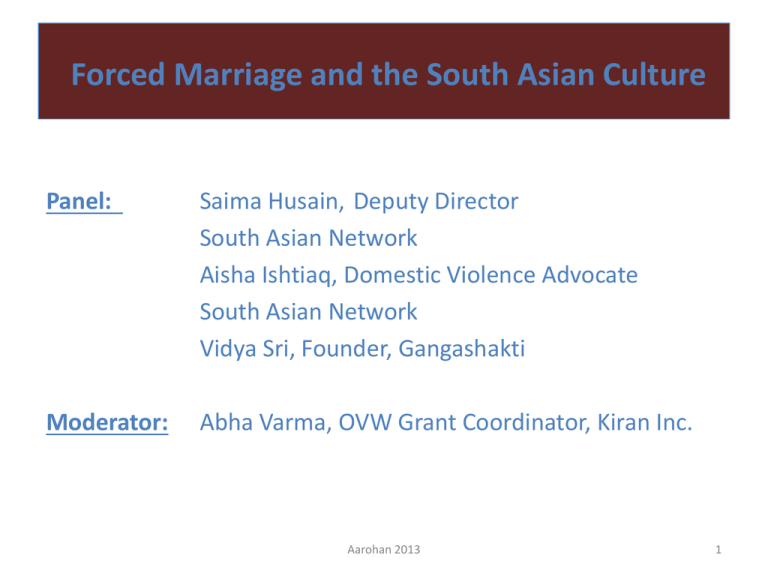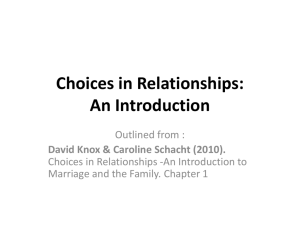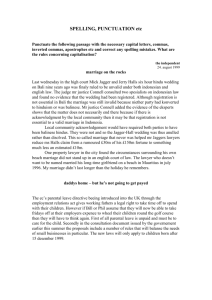
Forced Marriage and the South Asian Culture
Panel:
Saima Husain, Deputy Director
South Asian Network
Aisha Ishtiaq, Domestic Violence Advocate
South Asian Network
Vidya Sri, Founder, Gangashakti
Moderator:
Abha Varma, OVW Grant Coordinator, Kiran Inc.
Aarohan 2013
1
Universal Declaration of Human Rights,
Article 16(2)
“Marriage shall be entered into only
with the free and full consent of the
intending spouses.”
Aarohan 2013
2
UN Convention on consent to marriage, minimum age
for marriage and registration of marriages, Article 1
“No marriage shall be legally entered
into without the full and free
consent of both parties.”
Aarohan 2013
3
UN Convention on the Elimination of All Forms
of Discrimination Against Women
“A woman’s right to choose a spouse
and enter freely into marriage is
central to her life and her dignity
and equality as a human being.”
(General Recommendation No.21, Comment Article 16
(1) (b),)
Aarohan 2013
4
One Potential Version of an Arranged to Forced
Marriage Continuum
Family
Suggests
Need for
Marriage
Family
Insists on
Control of
Process
Individual
Questions
Process &
Intent
Family
Dismisses
Need for
Consent
Family Uses
Shaming
Gangashakti.org
Family Uses
Violence to
Reinforce
Shaming
Individual is
Denied
Right of
Refusal
Individual is
Forced into
Marriage
5
Forced Marriage and the South Asian
Culture
Forced Marriage:
Forced marriage is a marriage that has an absence of consent from one or both
parties and uses one or more elements of coercion, violence, and/or fraud to
cause the marriage.
There is no ability to choose one’s partner and the right of refusal may be denied
by the family for one or both individuals.
There is an absence of free will in a forced marriage that differentiates it from
other types of marriages including an arranged marriage where, although the
parties to the marriage are introduced to each other, the final decision to marry
remains with the two parties.
Forced marriage is distinguishable from other forms of violence by the complicit
role the family and community play in perpetrating the violence.
Aarohan 2013
6
Forced Marriage and the South Asian Culture
“Honor” Violence:
The terms “honor crime” or “honor-based violence” embrace a
variety of crimes of violence (mainly but not exclusively against
women), including assault, imprisonment and murder, where the
person is being punished by their family or their community.
They are being punished for actually, or allegedly, undermining
what the family or community believes to be the correct code of
behavior.
In transgressing this correct code of behavior, the person shows
that they have not been properly controlled to conform by their
family and this is to the “shame” or “dishonor” of the family.
Aarohan 2013
7
Forced Marriage and the South Asian Culture
Arranged Marriage:
The families of both spouses take a leading role in arranging the marriage
but the choice whether or not to accept the arrangement remains with
the prospective spouses.
Consent is essential to all marriages – only the spouses will know if they
gave their consent freely.
Remember, If families have to resort to violence or emotional pressure to
make someone marry, that person’s consent has not been given freely and
therefore it may not be “arranged.”
Aarohan 2013
8
Forced Marriage and the South Asian
Culture
Some Causes of Forced Marriage
•
•
•
•
•
•
Forced marriage can happen at any age to minors and adults including individuals
with physical or mental disabilities.
Such a marriage can be used to execute a financial transaction.
Control perceived “inappropriate” and/or sexual behavior.
Restrict an individual’s right to self-determine his/her choices including choosing a
life partner.
It is often used to ensure that an individual is adhering to a pre-determined code
of conduct.
Forced marriage is also used to control the chastity of an individual and uphold so
called family “honor.”
Aarohan 2013
9
Types of Violence Used – Impact on Victims of FM
Homicide
Suicide
Sexual Abuse
Attempted Suicide
Immigration Issues
Self-Harm
Forced/Abandoned Overseas
Alcohol & Substance Abuse
Isolation/False Imprisonment
Poor Work/Academic Record
Physical/Economic Abuse
Excessive Absence from Work/School
Coercion/Intimidation
Depression
Gangashakti.org
10
Overview of 2012 Forced Marriage Survey
• 524 Survey
Respondents including
social workers,
students, law
enforcement, at-risk
individuals and scholars
in women’s studies.
• 37% were aware of known
cases of forced marriage in
the United States.
• In fact, these respondents
stated that they were aware
of 563 cases.
• 53% stated that they were
aware of suspected cases of
forced marriage in the
United States.
Gangashakti.org
11
Major Recommendations on FM
from 2012 Study
Major Recommendations on FM From Interviewees
Further Research on FM
9%
Clarity Between Arranged and Forced…
18%
Multi-Disciplinary Approach to Cases
18%
Further Collaboration among NGO's
23%
Educate the Youth
32%
Criminal Justice Response
45%
Educate Communities on Prevention
45%
Services for Victims
55%
Cultural Sensitivity Training
68%
Raise Awareness of Forced Marriage
95%
Gangashakti.org
12
Value of Marriage
Marriage seen as a valued entity in the South Asian community
Marriage most respected or valued accomplishment, more than
education, employment, independence, etc.
Women in abusive relationships do not seek safety or separation
DV survivors who leave frequently re-marry quickly, told they
cannot be alone and need a man in their lives
Young women told they “need a man”
Young women told marriage will bring them safety, security and
status
Told they will have more freedom when they marry, they can
travel etc.
Aarohan 2013
13
Pressure begins early
Pressure to get married for young women begins in their late
teens, early 20s
The pressures come from grandparents, extended family and
also immediate family
If women are not married they are made to feel inadequate
The age at which this happens varies and depends on what
is the norm and what is happening in the community.
Ranges from 20-26
Pressure also from friends and peers
Aarohan 2013
14
Control and Coercion
Pressure takes the form of silent treatment, blaming
the young woman for all the family’s problems,
fights, health concerns etc.
Women must limit their education and employment
options
Told not to pursue higher education – limits their
pool of suitors as a woman has to be “less educated
than her husband”
Cannot pursue employment that is more than 9-5
pm or that requires out of state travel
Aarohan 2013
15
Little choice
Not allowed to plan future, ask questions of future
spouse
Even when they are not forced to marry someone of
their family’s choosing, have little leeway in their
choice of spouse
Potential partner has to have a certain education,
look good on paper, has to be South Asian or be of
the same religious background
Many women are told the person has to be from
the same ethnic group (Punjabi, Sindhi, Gujarati
etc) or the same village as them
Aarohan 2013
16
Taught to self-sacrifice
Feel they have to choose between their family/community and
what they want
Do not want to be part of the community that judges them
but it is hard to leave as their parents and siblings are part of
the community
If they stay they know they have to change and give up parts
of themselves to fit in
Women expected to sacrifice themselves for family/community
Women feel like they are the only ones facing this pressure, they
feel alone
Women need to know that they have choices
Even the women who date or can talk to potential suitors find it
difficult to ask questions relating to their future and the
marriage (as opposed to the wedding)
Aarohan 2013
17
Wedding vs. Marriage
Weddings more valued than actual marriage
More thought/preparation placed on wedding customs/rituals
Everything has to be just perfect on wedding day
Bride/Groom told to be on best behavior during wedding and to look perfect
Not given any advice on how to act/behave after the wedding is over
Bride/Groom given a false sense of importance during the wedding by
guests/relatives
Bride/Groom given a false sense of reassurance that marriage is easy
during wedding day
Harmful advice is given to bride/groom during the wedding
After the wedding, nothing is discussed and no advice is given
Married couple realize the realities of married life after the honeymoon
period is over
Many are unable to handle the expectations and responsibilities of marriage
Aarohan 2013
18
SAN Focus Groups
Age 20-35
Single/engaged and
currently/formerly married
South Asian Women
Provide safe space to discuss
pressures/realities of marriage
within South Asian culture
how marriage has influenced
their decision on other life
goals, such as education,
occupation, living on their own,
travel, etc
Married participants able to
provide useful advice to
single/engaged participants on
what to expect when married
Aarohan 2013
19
SAN Focus Groups Con’t.
Use focus groups to bring South
Asian women together
Build a supportive network for
women experiencing similar
situations
create their own community that
is accepting
Assist women to become leaders
in their communities and talk
openly about the topic of
marriage and the expectations it
places on South Asian women
alone
Talk to young female teens about
the expectations and
responsibilities of marriage and
alternative options
Aarohan 2013
20
SAN’s goal
SAN’s vision is to prevent violence not just by
demonstrating healthy relationships
Offer pre-marital counseling, partnering with faith-based
leaders, bridal shows etc.
Engage older women and men
Rewrite the rules and expanding horizons about women’s
roles, what is possible for women and expected of
women
Changing cultural norms around marriage and its value
Aarohan 2013
21
Forced Marriage and the South Asian
Culture
• Closing Comments
• Q&A
Copyright 2013 . All rights reserved. No part of this document may be reproduced or transmitted in any form,
by any means (electronic, photocopying, recording, or otherwise) without the prior written permission of the
publishers. No unauthorized use permitted; all derivative works must have prior approval from the publishers.
Aarohan 2013
22








